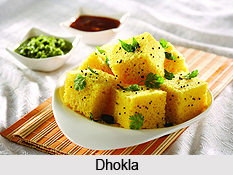Dhokla is a vegetarian food item that originates from the Indian State of Gujarat. It is made with a fermented batter derived from rice and chickpea splits. Dhokla can be eaten for breakfast, as a main course, as a side dish or as a snack.
 Origin of Dhokla
Origin of Dhokla
Dhokla originated from the western part of Gujarat many years ago. It is known all over as a popular Gujrati dish and a favorite vegetarian snack.
Types of Dhokla
A Dhokla can be made with different variations. There are different kinds of Dhoklas prepared with different ingredients and ratios of chickpeas. Some of the popular kinds of Dhoklas are:
•Khatta Dhokla
•Rasia Dhokla
•Khandhavi Dhokla
•Cheese Dhokla
•Toor Dal Dhokla
•Sandwich Dhokla
•Rawa Dhokla
•Mixed Dal Dhokla
•Green Peas Dhokla
•Khaman Dhokla
•Idada Dhokla
•Chawal Dhokla
Preparation of Dhokla
A Dhokla is a spongy savoury cake made of gram flour, sooji (semolina) or rice powder. Rice and chickpea splits in the ratio of 4:1 are soaked overnight. The mixture is ground and fermented for over night. The fermented batter is then steamed for about 15 minutes on a flat dish and cut into pieces. These chopped pieces are seasoned in hot oil with mustard seeds. Asafoetida and chopped green chillies can also be fried and, sometimes, an equal amount of water and a little sugar is added to this oil. It is usually served with deep fried chillies and chutney made of coriander. It is garnished with coriander and often with grated coconut.
Ingredients:
•350gms Gram flour
•1cup Curd
•1tsp Green Chillies paste
•1tsp Ginger paste
•Salt to taste
•1tsp Soda bi-carb / Eno fruit salt
•1 Lemon juice
•1/2 tsp Turmeric Powder
•1tbsp Oil
•1/3 cup Water
•2 tbsp Sugar
 For Tempering
For Tempering
•Few Curry leaves
•1tsp Mustard Seeds
•2tsp Oil
•Coriander Leaves
•2-3 Green Chillies
Preparation:
•In a bowl add gram flour, curd and water.
•Mix well and make a smooth batter. The batter should be of thick consistency.
•Add salt and set aside for 4 hours covered with a lid.
•Add ginger, green chilli paste and turmeric powder to the batter.
•Grease a baking dish.
•Now in small bowl take soda bi-carb or eno, 1tsp oil and lemon juice and mix well. Add this to the batter and mix well.
•Pour the batter into the greased pan and steam for 10-12 minutes or till done.
•Cool for sometime and cut into big cubes.
•Heat little oil in a small pan and add mustard seeds and curry leaves allow to splutter.
•Add water and sugar. Bring to boil.
•Remove and pour it over Dhoklas.
•Garnish with coriander and slit green chillies.
•Serve with green chutney.




















